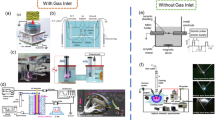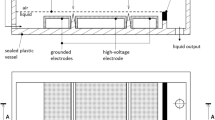Abstract
Non-thermal plasma is generated by excitation of the electron in gas or liquid medium. This technique has been applied to many industrial fields, especially for water treatment, because of the byproducts generated electrochemically by high-voltage discharge. Simultaneous production of plasma and bubbles is one of the methods to efficiently reduce the required energy for water treatment. The flow rate of injected gas and supplied electric energy are important parameters. In this study, the characteristics of the continuously generated bubbles with non-thermal plasma discahrge were investigated by experiment. The behavior of bubbles with and without discharge was analyzed by image processing. To verify the water treatment yield of bubbles with plasma generating byproducts, the decomposition of organic dye was investigated and analyzed. Due to the reduction of the surface tension of the interface, the volume of bubble with discharge showed shorter departure time with smaller volume. Bubbles with plasma discharge have faster bubble rising velocity, due to more spherical shape, which lowers the possibility of coalescence between bubbles, and is more effective for water treatment. The higher coalescence probability caused by increased Reynolds number resulted in the reduction of water treatment yield.
Similar content being viewed by others
Abbreviations
- A :
-
Calibration constant
- C :
-
Concentration
- ΔC :
-
Change of concentration
- I :
-
Current
- I abs :
-
Absorbance
- n coal :
-
The number of coalescence between bubbles
- n bub :
-
The number of production of bubbles
- P E :
-
Electric power
- P M :
-
Mechanical power
- Q :
-
Flow rate of gas
- R :
-
Radius of orifice
- Re :
-
Reynolds number in orifice
- T sat :
-
Saturated temperature
- T o :
-
Room temperature
- ΔT :
-
Temperature difference
- tt :
-
Time
- U a :
-
Applied electric potential
- U m :
-
Measured electric potential
- u :
-
Velocity of orifice
- u o :
-
Mean velocity
- Y E :
-
Electric yield
- Y m :
-
Mechanical yield
- Y :
-
Probability of coalescence between bubbles
- θ :
-
Contact angle of bubble
- λ :
-
Wave length
- μ :
-
Dynamic viscosity
- ρ :
-
Density
- T :
-
Dummy variable for time
References
W. Drenckhan and A. Saint-Jalmes, The science of foaming, Advanced Colloid Interface, 222 (2015) 228–259.
H. B. Al Ba’ba’a, T. Elgammal and R. S. Amano, Correlations of bubble diameter and frequency for air-water system based on orifice diameter and flow rate, Journal of Fluid Engineering, 138(11) (2016) 1–7.
A. Hamidi, M. Oshaghi, H. Afshin and B. Firoozabadi, Experimental investigation of various regimes of bubble formation and growth-A theoretical view of double coalescence regime, Journal of Fluid Engineering, 142 (4) (2019).
R. Thirumdas, C. Sarangapani and U. S. Annapure, Cold plasma: a novel non-thermal technology for food processing, Food Biophysics, 10(1) (2014) 1–11.
M. Magreanu, N. B. Mandache and V. I. Parvulescu, Degradation of pharmaceutical compounds in water by non-thermal plasma treatment, Water Research, 81 (2015) 124–136.
B. Jiang, J. Zheng, S. Qiu, M. Wu, Q. Zhang, Z. Yan and Q. Xue, Review on electrical discharge plasma technology for wastewater remediation, Chemical Engineering Journal, 236 (2014) 348–368.
M. A. Malik, Water purification by plasmas: which reactors are most energy efficient?, Plasma Chemistry and Plasma Processing, 30(1) (2009) 21–31.
W. T. Shin, S. Yiacoumi, C. Tsouris and S. Dai, A pulseless corona discharge process for the oxidation of organic compound in water, Industrial and Engineering Chemistry Research, 39 (2000) 4408–4414.
P. Bruggeman, C. Leys and J. Vierendeels, Experimental investigation of dc electrical breakdown of long vapour bubbles in capillaries, Journal of Physics D: Applied Physics, 40(7) (2007) 1937–1943.
S. Uehara, K. Ishihata and H. Nishiyama, Development of a capillary plasma pump with vapour bubble for water purification: experimental and theoretical investigation, Journal of Physics D: Applied Physics, 49 (40) (2016).
N. Sano, T. Kawashima, J. Fujikawa, T. Fujimoto, T. Kitai and T. Kanki, Decomposition of organic compounds in water by direct contact of gas corona discharge: Influence of discharge conditions, Industrial and Engineering Chemistry Research, 41 (2002) 5906–5911.
L. Na, L. Jie, W. Yan and M. Sato, Treatment of dye wastewater by using a hybrid gas/liquid pulsed discharge plasma reactor, Plasma Science and Technology, 14(2) (2012) 162–166.
Y. S. Chen, X. S. Zhang, Y. C. Dai and W. K. Yuan, Pulsed high-voltage discharge plasma for degradation of phenol in aqueous solution, Separation and Purification Technology, 34(3) (2004) 5–12.
W. Bian, X. Ying and J. Shi, Enhanced degradation of p-chlorophenol in a novel pulsed high voltage discharge reactor, Journal of Hazardous Materials, 162(3) (2009) 906–912.
L. Na, F. Yingchun, L. Jie, S. Yan, S. Kefeng and W. Yan, Electrical characteristics of pulsed corona discharge plasmas in chitosan solution, Plasma Science and Technology, 16(2) (2014) 128–133.
M. Magureanu, N. B. Mandache and V. I. Parvulescu, Degradation of organic dyes in water by electrical discharges, Plasma Chemistry and Plasma Processing, 27(5) (2007) 589–598.
P. Bruggeman, D. Schram, M. A. González, R. Rego, M. G. Kong and C. Leys, Characterization of a direct dc-excited discharge in water by optical emission spectroscopy, Plasma Sources Science and Technology, 18 (2) (2009).
Y. Hayashi, N. Takada, H. Kanda and M. Goto, Effect of fine bubbles on electric discharge in water, Plasma Sources Science and Technology, 24 (5) (2015).
P. Vanraes, A. Nikiforov and C. Leys, Electrical and spectroscopic characterization of underwater plasma discharge inside rising gas bubbles, Journal of Physics D: Applied Physics, 45 (24) (2012).
K. Yasuoka, K. Sasaki and R. Hayashi, An energy-efficient process for decomposing perfluorooctanoic and perfluorooctane sulfonic acids using dc plasmas generated within gas bubbles, Plasma Sources Science and Technology, 20 (3) (2011).
N. Takeuchi, Y. Ishii and K. Yasuoka, Modelling chemical reactions in dc plasma inside oxygen bubbles in water, Plasma Sources Science and Technology, 21 (1) (2012).
T. Miichi, S. Ihara, S. Satoh and C. Yamabe, Spectroscopic measurements of discharges inside bubbles in water, Vacuum, 59 (2000) 236–243.
A. Yamatake, J. Fletcher, K. Yasuoka and S. Ishii, Water treatment by fast oxygen radical flow with DC-driven micro hollow cathode discharge, IEEE Transactions on Plasma Science, 34(4) (2006) 1375–1381.
M. Magureanu, D. Piroi, F. Gherendi, N. B. Mandache and V. Parvulescu, Decomposition of methylene blue in water by corona discharges, Plasma Chemistry and Plasma Processing, 28(6) (2008) 677–688.
M. Magureanu, C. Bradu, D. Piroi, N. B. Mandache and V. Parvulescu, Pulsed corona discharge for degradation of methylene blue in water, Plasma Chemistry and Plasma Processing, 33(1) (2012) 51–64.
M. Laroussi, I. Alexeff, J. P. Richardson and F. F. Dyler, The resistive barrier discharge, IEEE Transactions on Plasma Science, 30(1) (2002) 158–159.
P. K. Weissenborn and R. J. Pugh, Surface tension of aqueous solutions of electrolytes: relationship with ion hydration, oxygen solubility, and bubble coalescence, Journal of Colloid and Interface Science, 184 (1996) 550–563.
S. V. Gnyloskurenko, A. V. Byakova, O. I. Raychenko and T. Nakamura, Influence of wetting conditions on bubble formation at orifice in an invscid liquid. Transformation of bubble shape and size, Colloids and Surfaces A: Physicochemical and Engineering Aspects, 218 (2003) 73–87.
A. Albadawi, D. B. Donoghue, A. J. Robinson, D. B. Murray and Y. M. C. Delaure, On the analysis of bubble growth and detachment at low capillary and bond numbers using volume of fluid and level set methods, Chemical Engineering Science, 90 (2013) 77–91.
D. Gerlach, N. Alleborn, V. Buwa and F. Durst, Numerical simulation of periodic bubble formation at a submerged orifice with constant gas flow rate, Chemical Engineering Science, 62 (2007) 2109–2125.
I. Chakraborty, B. Ray, G. Biswas, F. Durst, A. Sharma and P. S. Ghoshdastidar, Computational investigation on bubble detachment from submerged orifice in quiescent liquid under normal and reduced gravity, Physics of Fluids, 21 (2009).
Acknowledgments
This work was supported by the Basic Science Research Program through the National Research Foundation (NRF), Korea (2019R1A2C2003176), funded by the Korean Government and Korea Institute for Advancement of Technology (KIAT) grant funded by the Korean Government (MOTIE) (P0008458, The Competency Development Program for Industry Specialist).
Author information
Authors and Affiliations
Corresponding author
Additional information
Jae Won Lee is a graduate student of the School of Mechanical Engineering, Sungkyunkwan University, Suwon, Korea. He received his B.S. in Mechanical Engineering from Sungkyunkwan University. His research interests include computational fluid dynamics (CFD) about muti-physics system including electric effect inside the flow field.
Dong Kee Sohn is a Research Professor at the School of Mechanical Engineering, Sungkyunkwan University. He received his Ph.D. in Mechanical Engineering from Seoul National University in 1997. His research interests include experiments for heat and fluid system.
Han Seo Ko is a Professor at the school of Mechanical Engineering, Sungkyunkwan University. He received his Ph.D. in Mechanical Engineering from Texas A&M University in 1998. His research interests include flow control, microfluidics, optical tomography, micro-droplet ejection and heat and mass control.
Rights and permissions
About this article
Cite this article
Lee, J.W., Ji, Y.Y., Sohn, D.K. et al. Enhancement of continuous bubbles by non-thermal plasma for water treatment. J Mech Sci Technol 35, 2503–2511 (2021). https://doi.org/10.1007/s12206-021-0521-4
Received:
Revised:
Accepted:
Published:
Issue Date:
DOI: https://doi.org/10.1007/s12206-021-0521-4




